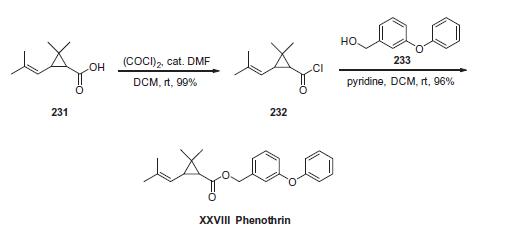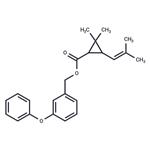Phenothrin is pale yellow to yellow–brown clear liquid with a
faint characteristic odor.
Pale yellow to yellow-brown liquid
Phenothrin is an insecticide used in commercial and industrial
settings, medical institutions, and other institutional settings.
Phenothrin is formulated for use in greenhouses, homes, and
gardens, and in recreational areas. Additionally, phenothrin
has public health uses, specifically its use for vector control for
mosquitoes both indoor and outdoor.
ChEBI: Phenothrin is a cyclopropanecarboxylate ester. It has a role as a pyrethroid ester insecticide. It is functionally related to a chrysanthemic acid.
Pale yellow to yellow-brown liquid. Non corrosive. Used as an insecticide.
Insoluble in water. Hydrolyzed by alkalis.
Insecticide: Used world-wide to control household insects and
to protect stored grain. It is frequently formulated withother insecticides and is formulated in a number of carriers
(aerosols, oil, dust, emulsifiable concentrates), and in
powders, shampoos and lotion.
FORTE®; MULTICIDE-2154®; OMS
1809®; OMS 1810®; PHENOXYTHRIN®; PT-515;
S-2539®; SUMETHRIN®; SUMITHRIN®; WELLCIDE®
Note: The U.S. EPA currently lists 724 active or canceled
products, 242 of which are active. Most products are for
residential flying insect control, e.g., fleas, wasps, flies,
mosquitoes. Not approved for use in EU countries[115].
Registered for use in the U.S. and Canada
Low toxicity by ingestion and skin contact. When heated to decomposition it emits acrid smoke and irritating vapors.
Commercially available chrysanthemic
acid (231) was converted to the corresponding acyl chloride
232 in 99% yield. Further condensation with 3-
phenoxyphenyl methanol (233) in pyridine provided phenothrin
(XXVIII) in 96% yield.

d-Phenenothrin is a pyrethroid insecticide whic is used world-wide to control household insects and to protect stored grain. It is frequently formulated with other insecticides and is formulated in a number of carriers (aerosols, oil, dust, emulsifiable concentrates), and in powders, shampoos and lotion.
Routes and pathways relevant physicochemical
Phenothrin is a pale yellow to brown clear liquid with a faint
characteristic odor. Its reported solubility is very low<9.7 mg l-1 at 25 °C. It has a low vapor pressure of 1.43 × 10-7 mmHg
at 21 �C, and a calculated Henry’s Law constant of 6.80 �
10-6 atm-m3 mol-1. The octanol/water partition coefficient
for phenothrin is 1.03 × 106 (log Kow ? 6.01 at 20 °C).
UN3082 Environmentally hazardous substances, liquid, n.o.s., Hazard class: 9; Labels: 9-Miscellaneous hazardous material, Technical Name Required. UN3349 Pyrethroid pesticide, solid toxic, Hazard Class: 6.1; Labels: 6.1-Poisonous material. UN3352 Pyrethroid pesticide, liquid toxic, Hazard Class: 6.1; Labels: 6.1-Poisonous materials.
Acute oral LD50 for rats: >5,000 mg/kg
Keep away from alkaline materials. May react violently with strong oxidizers, bromine, 90% hydrogen peroxide, phosphorus trichloride, silver powders or dust. Incompatible with silver compounds. Mixture with some silver compounds forms explosive salts of silver oxalate. Compounds of the carboxyl group react with all bases, both inorganic and organic (i.e., amines) releasing substantial heat, water and a salt that may be harmful. Incompatible with arsenic compounds (releases hydrogen cyanide gas), diazo compounds, dithiocarbamates, isocyanates, mercaptans, nitrides, and sulfides (releasing heat, toxic and possibly flammable gases), thiosulfates and dithionites (releasing hydrogen sulfate and oxides of sulfur).
Incineration would be an effective disposal procedure where permitted. If an efficient incinerator is not available, the product should be mixed with large amounts of combustible material and contact with the smoke should be avoided. In accordance with 40CFR165, follow recommendations for the disposal of pesticides and pesticide containers




